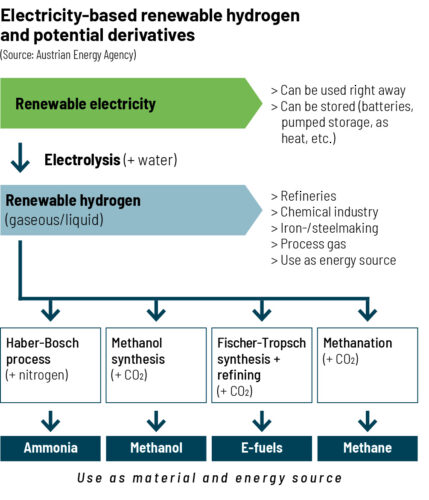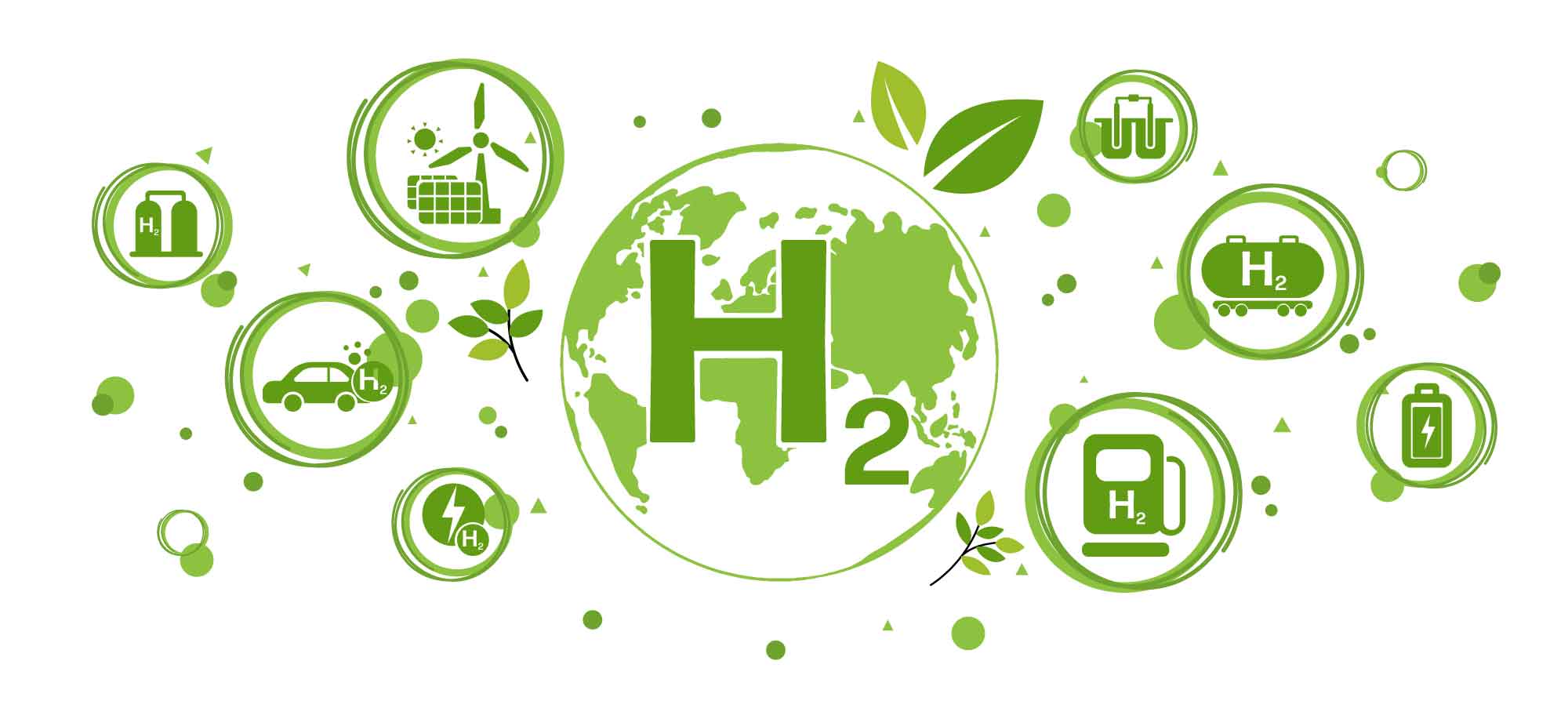Hydrogen (H2) is a flexible energy carrier with the potential to become a key component of the energy transition. Up until now, it has primarily been used in refinery processes and in the chemical industry and produced mainly from fossil energy sources. On an industrial scale, it is generally obtained through a process known as natural gas reforming, which involves the catalytic steam cracking of methane. However, hydrogen produced in a climate-neutral way is expected to replace that generated from fossil fuels in the future in order to drive forward the decarbonisation of industry. Many other energy-intensive industrial processes that cannot be electrified either easily or at all, such as steelmaking, could be converted from coal and natural gas to hydrogen, thus saving large quantities of carbon emissions.
Hydrogen is poised to play a major role in the energy system of the future. Energy conversion using “power-to-gas” technology opens up a wealth of options such as storing renewable energy from the summer into the winter or integrating the power, heat and mobility sectors. Surplus wind and solar power can be converted into hydrogen by means of electrolysis. The “green” hydrogen that this produces can then be used by industry (as either an energy source or a material) or stored (e.g. in disused natural-gas storage facilities) and fed back into the grid later on. Hydrogen is also a base product for a wide variety of derivatives such as ammonia, methanol, e-fuels and synthetic methane. In the mobility sector of the future, hydrogen and/or energy carriers derived from it could replace fossil fuels in heavy-duty transport in particular as well as in aviation and shipping.

(Source: Austrian Energy Agency)
Making green hydrogen
There are currently two main ways to produce green hydrogen commercially: electrolysis and biogenic hydrogen production using biomass gasification processes. Electrolysis has a particularly important role to play as a technology of the future that harnesses sector integration.
It uses an electrical current to split water (H2O) into hydrogen (H2) and oxygen (O). In the process, the electrical energy is converted to chemical energy and stored in the hydrogen. If this electrolysis is done using electricity from renewable energy sources, no CO2 is produced that could harm the climate. Fuel cells can then be used to convert the energy that had previously been stored chemically inside the hydrogen back into electricity. Integrating electrolysis plants into the energy system also opens the door to system services that benefit the grid by balancing energy generation and energy consumption within the power system.
Austria’s hydrogen strategy
The federal government unveiled a national hydrogen strategy in 2022 to kick-start the expansion of Austria’s hydrogen industry. The aim is to make hydrogen production an integral part of the energy system. Climate-neutral hydrogen and its derivatives are chiefly to be used in sectors that lack an alternative decarbonisation pathway, e.g. via electrification. Alongside “green” hydrogen, the term “climate-neutral hydrogen” also includes hydrogen produced from natural gas using complete carbon sequestration as soon as the relevant technology is sufficiently mature (“blue hydrogen”) as well as that generated using pyrolysis (“turquoise hydrogen”). The aim by 2030 is to build 1 GW of electrolysis capacity and replace most of the hydrogen generated from fossil fuels with its climate-neutral equivalent in energy-intensive industry sectors. The strategy also sets out to develop the necessary hydrogen infrastructure and forge international partnerships for climate-neutral hydrogen. In addition, research and technology development along the entire hydrogen value chain are intended to help strengthen Austria as a technology hub and business location.
sollen auch zur Stärkung des Wirtschafts- und Technologiestandorts Österreich beitragen.
www.bmk.gv.at/themen/energie/publikationen/wasserstoffstrategie.html
Hydrogen in Austria
132,000 tonnes of H2 amount of hydrogen currently needed every year in Austria (according to the Fuel Cells and Hydrogen Observatory)
13,2 megawatts installed electrolyser capacity in Austria (as of May 2023)
EUR 60 million research spending on hydrogen in Austria (2021 and 2022)
Hydrogen Partnership Austria (HyPa)1
This joint initiative by the Federal Ministry for Climate Action, Environment, Energy, Mobility, Innovation and Technology (BMK) and the Federal Ministry of Labour and Economy (BMAW) is pooling Austria’s strengths to deliver its national hydrogen strategy. The platform is conducting an overarching dialogue process in order to incorporate views from business and industry leaders, researchers and civil society representatives into the design of regulations and funding mechanisms in a productive way. HyPA is supplying facts and information on the latest developments in the hydrogen field, organising events and providing an international showcase and an overview of funding opportunities. Its other services include giving initial and funding advice to companies and organisations, running study tours to trial sites and facilitating participation in trade fairs. The initiative is assisted by a high-calibre advisory board that draws up recommendations for the attention of the competent ministries, thus lending efficient and effective support to efforts to ramp up Austria’s hydrogen industry.
www.hypa.at
Austria Power & Gas Model Region Hydrogen Initiative (WIVA P&G)
The aim of the WIVA P&G model region (working on behalf of the Climate and Energy Fund) is to trial the Austrian economy’s switch to a largely hydrogen-based energy system. The WIVA P&G research association is encouraging innovative developments in application, grid and storage technologies for hydrogen and renewable gases, coordinating the various activities and helping to communicate project results.
www.wiva.at
Current R&D projects in Austria are studying hydrogen technologies and applications along the entire value chain, i.e. from the production and storage of climate-neutral hydrogen through to its distribution and consumption, and are trialling them in the first pilot plants. We introduce some of these pioneering projects in this issue.
1 The “Hydrogen Partnership Austria” (HyPA) platform merged the two previous initiatives “H2Austria” (BMK) and “Hydrogen Austria” (BMAW). It is being implemented by the Austrian Energy Agency and the Standortagentur Tirol.
